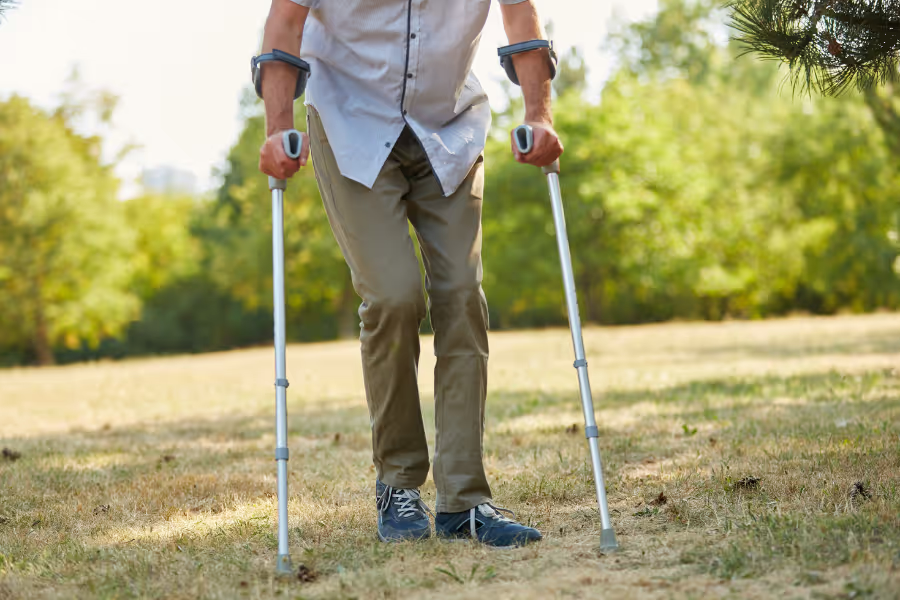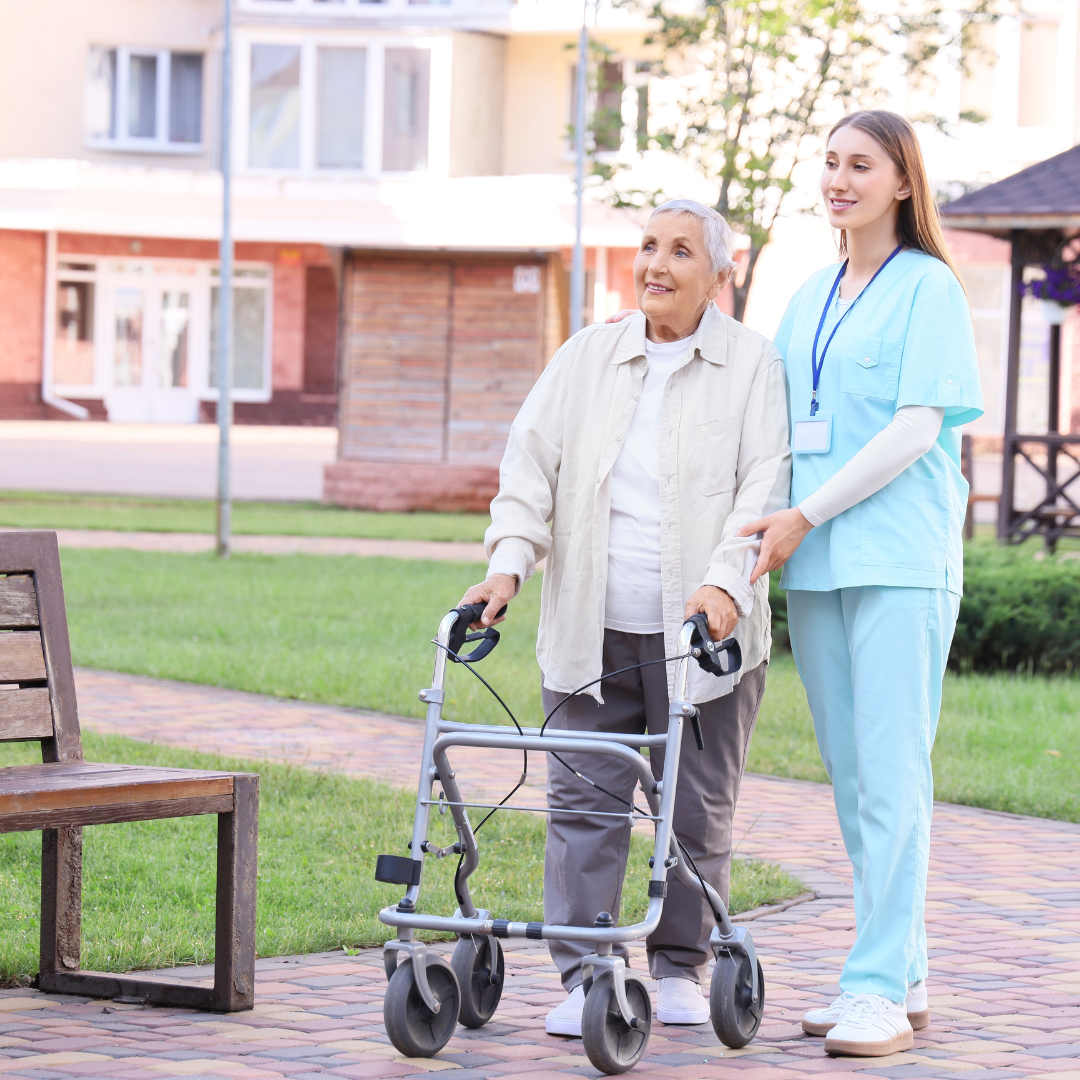When Can You Start Walking After Hip Surgery?
For most people, walking after hip surgery starts surprisingly early.
- Many patients take their first steps within 24 hours of surgery, using a walker or crutches under a physiotherapist’s supervision.
- In the first few days, short, light walks inside the hospital room or hallway help maintain circulation and prevent stiffness.
- How much weight you can safely put on your new hip depends on your surgeon’s instructions and whether you have a cemented or uncemented implant.
Cemented implants are often more stable right away, so some patients can put more weight on the leg earlier. With uncemented implants, the bone needs more time to grow around the implant, so weight-bearing may be slower.
First 24–72 Hours After Hip Surgery
In the first 1–3 days, the focus is on safety and confidence, not distance.
You can expect:
- Assisted walking with a physiotherapist, using a walker or crutches
- Help getting out of bed, standing, and sitting safely
- Several short walks in your room or hallway each day
- Simple exercises to keep ankles, knees, and hips moving
The main goals in this window are:
- Keeping blood flowing to lower the risk of clots
- Protecting the new hip and avoiding falls
- Showing you that you can stand and walk again
Early Walking Milestones (Day 0–3)
- Day of surgery (Day 0): Sit at the edge of the bed, stand with help, take a few steps if safe (with walker or crutches and physiotherapist).
- Day 1: Short walks in the room or hallway, several times a day (with walker or crutches).
- Day 2–3: More frequent short walks; practice getting in and out of bed and a chair (with walker or crutches and nursing/physio support).

First 2–3 Weeks: Building a Walking Routine
From Week 1 to Week 3, the goal is steady walking progression after hip surgery, not big jumps.
Common milestones include:
- Gradually increasing indoor walking distance at home
- Moving from walker → crutches → cane after hip replacement, depending on balance and strength
- By around Week 3, many people can walk short distances indoors without a walking aid, though some still prefer a cane for confidence
Your hip mobility recovery in this phase is closely tied to your exercise plan. Regular strengthening of your hip, thigh, and core helps you walk more smoothly and safely.
Is it good to walk a lot after hip surgery?
It's good to walk, but the amount depends.
In a multicentre study, it was found that patients mobilized within 2 days of (hip fracture) surgery had 3.27x higher odds of independent walking at week 1 and 3.33x higher odds at discharge.
Early walking has also been shown to prevent venous thromboembolism, pneumonia, urinary tract infections, blood clots, and other complications.
Walking is essential for hip replacement recovery, but more is not always better in the early weeks. Take your cues from your surgeon/physio, increase slowly day to day, and stop if you notice sharp pain, rising swelling, or a worsening limp.
When Can You Walk Normally Without Any Walking Aid?
'Normal walking,' meaning a smooth, even gait without a limp on flat ground. You're not hiking Kilamanjaro, but you're comfortable walking around the neighbourhood.
While everyone is different, many patients:
- Start walking indoors without a walking aid between 3–6 weeks
- Still use a cane or walking pole outdoors or on uneven ground
- Notice their walking looks and feels more “normal” over 2–3 months, as muscles strengthen and their limp improves
Asymmetrical loading is expected for the first 6-12 weeks of surgery, so you may feel a limp for weeks, even after most of the pain subsides.

Weeks 3–6: Losing the Walker, Gaining Confidence
Between Week 3 and Week 6, typical milestones include:
- Unaided walking indoors for many patients
- Short outdoor walks on flat, safe surfaces
- Gradual increases in distance if pain and swelling stay manageable
- A clear link between consistent physiotherapy and faster progress
Patients who do their home exercises daily usually reach key hip replacement walking milestones sooner. Take physio seriously. The more you invest into diligent phsyio, the more you get out of it.
After 6 Weeks to 3 Months: Towards Normal Walking
From 6 weeks to 3 months, many people feel a big shift:
- Everyday walking patterns return closer to normal (though you may still feel a limp)
- Limping decreases as hip and thigh muscles get stronger
- Some stiffness or fatigue is still common, especially later in the day
By around 3 months, many patients can:
- Walk without support on flat ground
- Handle basic community outings (shopping, visiting family, short trips)
- Continue building endurance for longer walks over time
How long before you can walk unaided after hip surgery?
Many people walk unaided between 3 and 6 weeks, especially indoors. Outdoors, it is still wise to use a cane on uneven or icy ground. Your surgeon and physiotherapist will guide you based on your strength, balance, and specific surgery.
When can you put full weight on your leg after hip replacement?
This depends on:
- Whether your hip is cemented or uncemented
- The quality of your bone
- Your surgeon’s protocol
Some patients are allowed to put full weight on the leg almost right away. Others must use partial weight-bearing for a few weeks. Always follow your surgeon’s instructions to protect the implant and support long-term success.

Can You Walk Too Much After Hip Surgery? (Important Precautions)
Yes, it is possible to walk too much after hip surgery, especially in the first few weeks.
Overdoing it can:
- Increase inflammation and swelling
- Slow down healing
- Raise your risk of falls or a more severe limp
The safest approach is slow, steady progress. Small increases in walking time every few days are better than sudden jumps.
Red Flags to Avoid Overuse
Contact your care team if you notice:
- Swelling that keeps getting worse instead of settling overnight
- New or sharp pain that does not improve with rest, ice, or medication
- Reduced movement in the hip or a sudden change in how you walk
- Extreme fatigue that makes walking feel unsafe
Activities generally to avoid early on:
- Twisting at the hip without moving your feet
- Deep bending beyond your team’s advice
- Crossing your legs, if your surgeon has told you not to
Can you damage a hip replacement by walking too much?
Serious damage from walking alone is rare if you follow your weight-bearing after hip replacement instructions. Problems are more likely when people ignore pain, swelling, or safety advice. If you are unsure, ease back, rest, and ask your surgeon or physiotherapist.
What Affects How Fast You’ll Walk Normally Again?
Not everyone follows the same hip surgery timeline. Key factors include:
- Age and overall fitness
- Muscle strength and balance before surgery
- Other health issues, like arthritis in other joints or back problems
- The type of implant and surgical approach
- The quality and frequency of physiotherapy after hip replacement (cannot stress this enough)
Patient-Specific Factors
Your recovery speed is shaped by:
- Pre-surgery strength and mobility: Staying as active as possible before surgery often supports better recovery.
- Other conditions: Back pain, knee arthritis, or balance problems can slow walking progression.
- Home support: Help with meals, chores, and transportation lets you focus on exercises and rest.
- Exercise follow-through: Patients who stick to their home exercise program usually see more stable, confident walking sooner.
When to Consider Seeking Support Through Private Care
If you are facing long waits for hip surgery, private care will help you move forward sooner.
Surgency’s platform helps Canadians:




